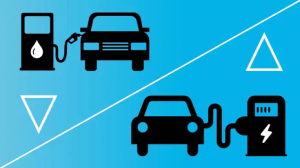Vehicle emission is one of the largest contributions to air pollution in the world. In order to reduce exhausts, people can choose to drive electric cars. Although electric cars seem to be more environmentally friendly, in my view, petrol and diesel-fueled cars cannot be completely replaced in the future because of their convenience and efficiency.

Electric cars vs. diesel-fueled cars; Photo courtesy by Chris Tosic
In terms of fuel efficiency, fuel-filling cars are more efficient than electric cars. Due to the limited capacity of batteries, fully charged electric cars normally cannot drive as far as fully fueled petrol and diesel cars. The usual battery life for today’s electric cars is about 100 to 150 kilometers. However, a fully fueled car with combustion engine can travel at least 400 to 500 kilometers normally. Although today’s most popular electric car brand “Tesla” has developed more powerful batteries for their electric cars to allow the driving distance to increase up to 572 kilometers, the price of the car with higher electric capacity becomes so high that it can be economically inefficient.
Apart from driving distance, the way of getting energy is another big concern for electric cars. In today’s community, we can find a lot more fuel-filling stations than electric charging stations in cities. Here is an example for the United States:

NO. of US Gas Stations VS. Electric Charging Stations; Data table provided by Loren McDonald
Moreover, the fuel charging only takes a few seconds or minutes to complete. In this case, we do not need to worry if the car does not have much fuel left. Conversely, electric cars take a much longer time to charge, and we do not have many electric charging stations in the city at present. For example, the total time required for a Tesla “90kWh Model S” electric car to be fully charged at a 30A public charging station is about 17.8 hours; even “Tesla Supercharger Station,” which is recognized as worlds’ fastest charging station, still takes 75 minutes to recharge an electric car. As we know, the higher capacity battery takes longer charging time. Therefore, petrol and diesel-fueled cars save much more time on fueling and cannot be completely replaced by the inconvenient electric cars.

